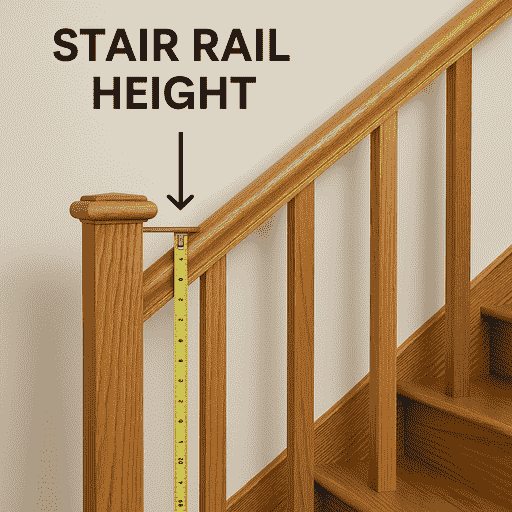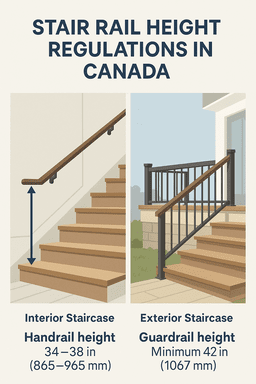Understanding stair rail height regulations is essential for homeowners, builders, and renovators in Canada. These regulations not only ensure safety but also ensure that your staircase meets the required stair railing height standards.
What Are Stair Rail Height Regulations in Canada?
In Canada, stair rail height regulations dictate the minimum and maximum height for railings to ensure safety. These standards help protect individuals from accidents caused by poorly designed or improperly installed staircases. For example, the stair handrail height must meet specific measurements to prevent falls.
The stair railing height typically ranges between 34 and 38 inches, depending on the jurisdiction. This is essential for all staircases, including residential and commercial properties. Stair railing height Ontario is no different, though certain regions may have variations based on the province’s building code.
Stair Rail Height by Province (Focus on Canada-wide Standards)
- Ontario:
In Ontario, the stair railing height must comply with the Ontario Building Code, which mandates a height of 36 inches. This ensures that stair railings provide the correct level of safety while still offering aesthetic appeal. - British Columbia:
Similarly, in British Columbia, regulations like stair railing height BC require the railing height to meet minimum safety standards, with specific variations depending on the property type. - Alberta:
Here in Alberta, the handrail height must be between 34 and 38 inches, according to the Alberta building code. Local municipalities may have slightly varying rules, so it’s important to consult your area’s regulations for compliance. - Other Provinces:
While regulations may vary slightly, stair railing height remains consistent in most provinces to ensure safety for all Canadian residents.
Why Proper Stair Rail Height Matters
- Safety:
The primary reason for these stair railing height regulations is to maintain safety. Having the correct stair handrail height helps prevent accidents, especially in homes with young children or elderly residents. - Legal Requirements:
Not adhering to local stair railing height rules can result in fines or being asked to modify the railing to meet code. Always check your local requirements, such as deck railing height Ontario, if you’re building or remodeling. - Aesthetic and Functional Considerations:
While safety is the main concern, stair railing height also plays an important role in the aesthetic and functional design of the staircase. For example, deck railing height can enhance the outdoor appearance of your home while keeping your family safe.
Choosing the Right Handrail Material and Style
- Materials:
When considering materials for your staircase railing, consider the weather in your region. In colder climates like Alberta, metal handrails and glass railings can withstand extreme weather conditions while maintaining their look and functionality. Additionally, the stair handrail height must be uniform across the entire staircase, ensuring that the materials you choose comply with regulations. - Styles:
Whether you choose wood, metal, or glass, make sure the stair rail height complements the overall style of your home. For example, aluminum railings might be ideal for modern homes, while wood railings fit more traditional designs.
How to Measure Stair Rail Height Correctly
- Step-by-Step Guide:
Measuring the correct stair railing height is essential. Begin by measuring from the top of the stair tread to the top of the handrail. Use a level to ensure consistency and make sure the railing height meets the required standards for your region. - Tools Needed:
You’ll need a tape measure, level, and a ladder for proper installation. Ensure that your stair railing height is consistent across the entire staircase for optimal safety and compliance with local regulations.


Common Mistakes to Avoid When Installing Stair Railings
- Incorrect Height:
One of the most common mistakes people make is not properly measuring the stair handrail height. This can result in non-compliance with the stair railing height Ontario standards and other provincial requirements. - Ignoring Local Codes:
Always ensure that your stair railing height adheres to your local building codes, such as deck railing height Ontario or regulations in Alberta. Non-compliance can result in expensive fixes and potentially dangerous situations.